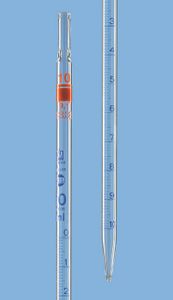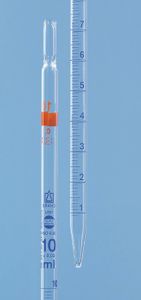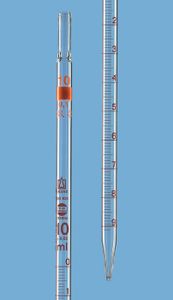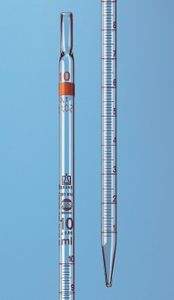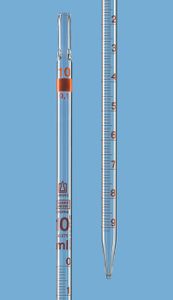What is the difference between class A and AS graduated pipettes?
Class A and AS refer always to highest quality grade in accord to the respective standards and 'S' stands for swift delivery only used for volumetric instruments calibrated to deliver, pipettes and burettes (TD, Ex). For volumetric instruments calibrated to contain (TC, In) a swift delivery is not necessary and therefore not defined in the respective standards.
Which kind of inscription is the best?
It depends on the application:
If you have to use aggressive cleaning conditions (aggressive scrubbing for example) pipettes with amber diffusion stain will be appropriate.
Pipettes with blue enamel provide high contrast and are usually appropriate for most applications.
There is a small amount of residual liquid in the tip. Should it be blown out or not?
No. The small amount of residual liquid must not be blown out as it is already taken into account during calibration of the bulb or graduated pipettes.
How can the meniscus be read easily?
The volume of a concave meniscus has to be read at the lowest point of the liquid level. Here the lowest point of the meniscus has to touch the upper edge of the graduation mark. For parallax-free adjustment of the meniscus, the burette is held upright and the observer's eye must be at the same height as the meniscus. In this position the ring mark will appear as a line. The meniscus will appear darker and more easily readable in front of a light background if a piece of dark paper is held behind the instrument immediately beneath the ring or graduation mark.
What are BLAUBRAND® and SILBERBRAND graduated pipettes labeled with?
Every BLAUBRAND® and SILBERBRAND bulb or graduated pipette is labeled with the nominal capacity, unit symbol (ml), error limit (± ml), calibration temperature (20 °C), calibration type (Ex), Class (AS or B), country of origin (Germany), color code, manufacturer's trademark (BLAUBRAND or SILBERBRAND) or companies name or logo (BRAND), as well as with standard referring to (ISO 648 or 835) and inscription ETERNA (if applicable).
Every BLAUBRAND® pipette is labeled with the following additional information; DE-M marking for all pipettes, waiting time in combination with calibration type in the format (Ex + 5 s), batch or serial number, and in case of USP pipettes the inscription USP.
Can you explain the waiting time for graduated pipettes?
The waiting time begins when the meniscus comes to rest at the lower volume mark or in the tip: During the waiting time residual liquid continues to flow down from the glass wall.
You only have to consider the waiting time of 5 s for BLAUBRAND® pipettes (cl. AS) before you remove the tip from the inner surface of the vessel. For SILBERBRAND pipettes (cl. B) no waiting is prescribed.
How do the three types of graduated pipettes differ in handling?
Due to the different scale graduated pipettes differ in handling as follows:
Type 1:
Set the meniscus at zero point and discharge the liquid to lower volume.
Type 2:
Set the meniscus for the volume intended to deliver and discharge the liquid completely.
Type 3:
Set the meniscus at zero point and discharge the liquid partially to one lower volume mark or completely.
What is the difference between the three types of graduated pipettes?
Graduated pipettes contain a scale that differs as follow:
Type 1:
Nominal capacity above the tip and the zero point at top.
Type 2:
Nominal capacity at the top.
Type 3:
Zero point at top.
What pipette controllers can be used?
BRAND offers three different pipette controllers:
macro pipette controller (easy manual handling)
accu-jet pro (motorized controller)
classic pipette fillers (three different versions)
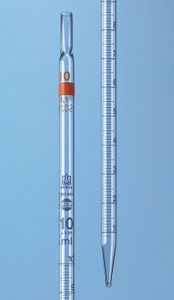 Pipettes graduées, BLAUBRAND®, classe AS, type 2, écoulement total, tc, ex, verre AR-GLAS®, DE-M
Pipettes graduées, BLAUBRAND®, classe AS, type 2, écoulement total, tc, ex, verre AR-GLAS®, DE-M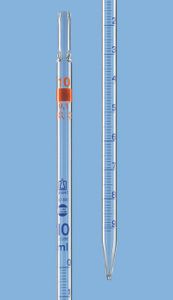 Pipettes graduées, BLAUBRAND®, classe AS, type 3, écoulement total, tc, ex, verre AR-GLAS®, DE-M
Pipettes graduées, BLAUBRAND®, classe AS, type 3, écoulement total, tc, ex, verre AR-GLAS®, DE-M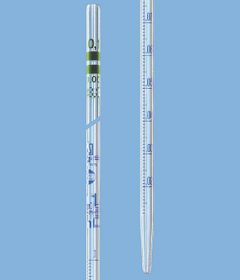 Pipettes graduées, BLAUBRAND®, classe A, type monobloc, tc, in, verre AR-GLAS®, DE-M
Pipettes graduées, BLAUBRAND®, classe A, type monobloc, tc, in, verre AR-GLAS®, DE-M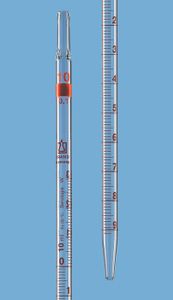 Pipettes graduées, sérologie, SILBERBRAND ETERNA, tc, ex, écoulement total, verre AR-GLAS®
Pipettes graduées, sérologie, SILBERBRAND ETERNA, tc, ex, écoulement total, verre AR-GLAS®
